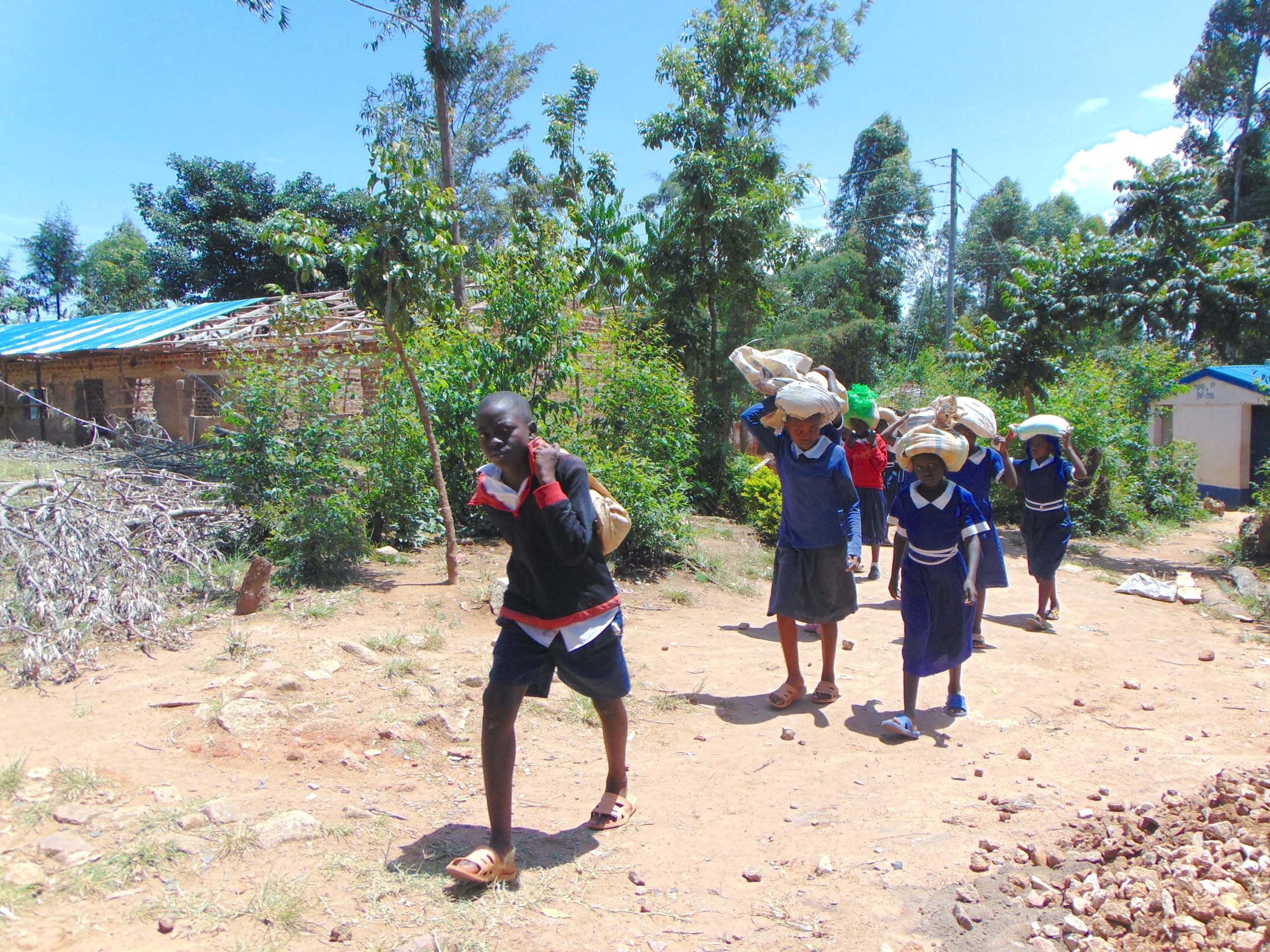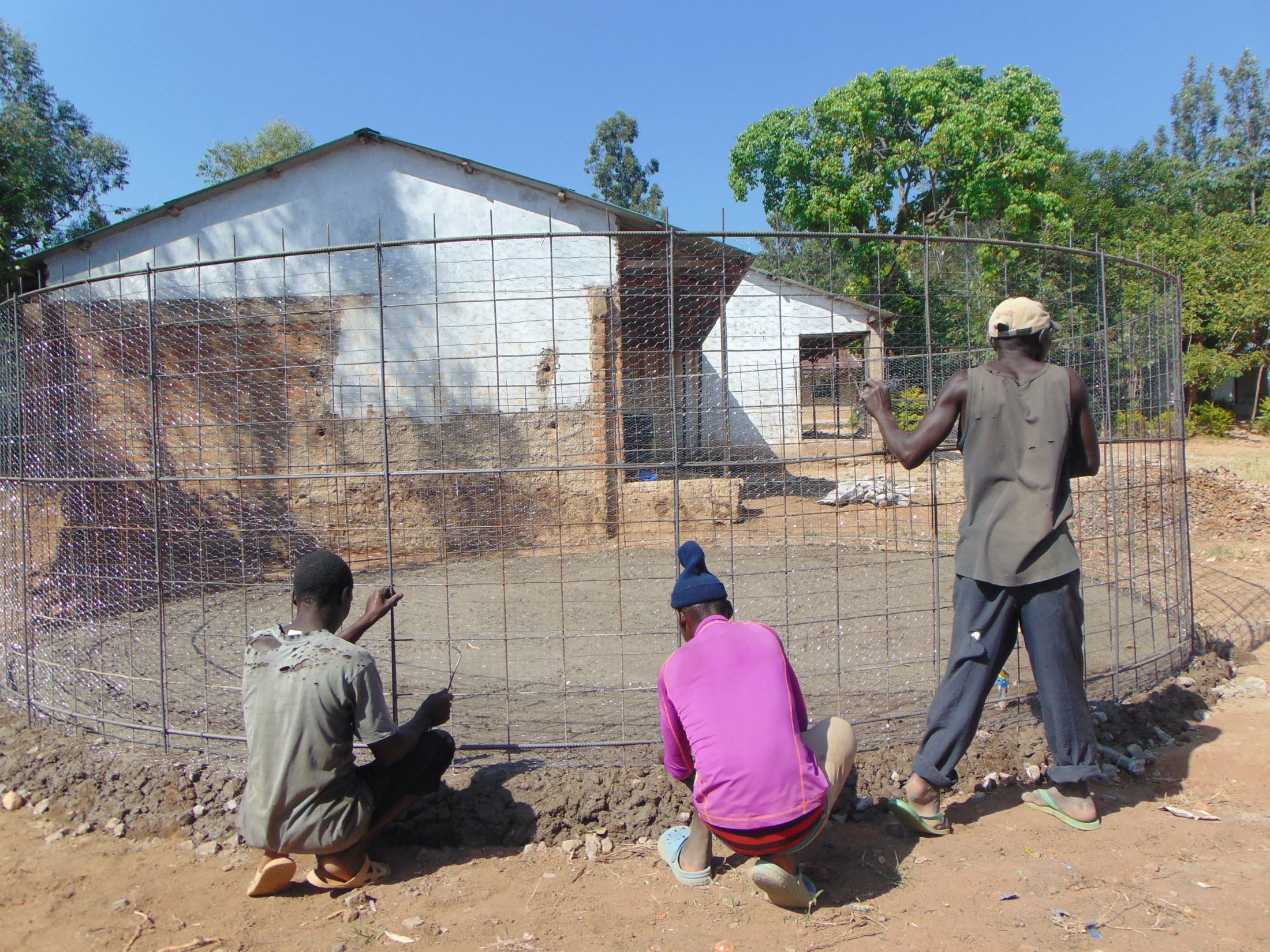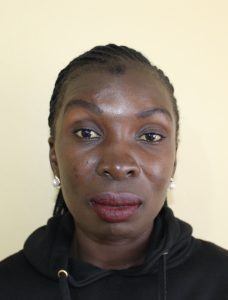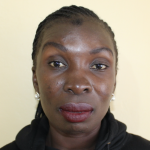July, 2020: Mutiva Primary School Project Complete!
Please note, all photos in this report were taken before social distancing recommendations went into effect.
Mutiva Primary School in Kenya now has access to a new source of safe, clean water thanks to the completion of their rain tank, which has the ability to collect 75,000 liters of water! We installed new latrines and handwashing stations for students, and we trained students and staff on improved sanitation and hygiene practices. All of these components work together to unlock the opportunity for these students to live better, healthier lives.

Students join hands over their new rain tank with water flowing
"Access to reliable, safe water from this water point will help impact my life positively. This is because I will fully concentrate on my studies well while I am in school, and not be going out during class time to collect water. The cook will also access water easily, hence our meals will not be late, giving me enough time to take lunch and run back to class. During the training, I got to learn that this tank will be cleaned and treated often; this is an assurance that I will be able to get clean drinking water," said pupil Kelvin.

"This water point will help me achieve better performance in my studies as I will now spend more time learning and being in class, not moving out of the school and walking long distances looking for water. Sometimes we could get harassed by the community members, and the teacher would instruct us to go to the next spring which was also far from school. This really wasted a lot of time. I have always wished to be in a school that has access to water in the compound, and now I am happy because my dreams have come true."

Teachers were just as excited as the students about the new rain tank on campus.
"The access to reliable, safe water from this water point will impact my life positively. This is because I am able to get enough clean water at any time I am in school, unlike before, when getting drinking water was real trouble," reflected school headteacher Mr. Shogi Odari.

Mr. Odari (left) with a Sanitation Teacher at the rain tank
"We as teachers would depend on water that was brought by children from the nearby spring, and sometimes this water was not clean. These are young children who could play on the way and even make the water dirty so by the time it could reach school, then its cleanliness could not be ascertained."

A student collects water from the rain tank
"As the school headteacher, my records will be positive since I am privileged to receive this project during my tenure. I am happy because the students will no longer waste time looking for water, and again I will not be worried when they go outside the school compound in search for water. This could sometimes cause me trouble with the Ministry of Education since if by any chance the officers in charge of education decided to visit the school at any time and found students out during learning hours, then me as the head could be in great trouble. I am happy for this project, and I am expecting better academic results at the end of this year."

While Kenyan schools remain closed until at least January 2021 due to the COVID-19 pandemic, these new water and sanitation facilities will be ready and waiting for the students' return. In the meantime, we will continue monitoring their rain tank and ensuring it is in top shape in their absence.

Rain Tank
Construction for this 75,000-liter rain tank was successful!
Before schools closed, parents, staff, and students helped our artisans gather everything needed for construction. All the while, the school cooks and community members prepared meals for the artisans, and the school provided accommodations for the artisans during their work. Local women and men helped our artisans with their manual labor, too.

Students helped carry bags of sand to the school construction site
The process officially began with our staff and school administration looking around the school compound to try and determine the best location for a new rain tank. This needed to be the best site with enough land and a nearby building with good, clean roofing to catch the rainwater.

Tap and drainage pipe placed over rain tank's stone and sand foundation
Then, we cleared the site by excavating the soil to make level ground for the tank foundation. The foundation was cast by laying big stones on the level ground and reinforcing them using steel wire, concrete, and waterproof cement. We affixed both the drawing pipe and the drainage pipe as we laid the foundation.

Pouring the rain tank's concrete foundation
Next, we formed the outer walls using a skeleton of rebar and wire mesh with sugar sacks temporarily tied to the outside as backing. This skeleton was attached to the foundation’s edges so that the work team could start the Ferro-cementing process, in which the walls are layered with cement alternating with the inner and outer side until 6 layers of cement are in place. (We remove the sugar sacks once the interior receives its first 2 layers of cement.)

Reinforcing the metal wire with wire mesh
Inside the tank, we cast 1 central and 4 support pillars to ensure the dome does not cave in once cemented. Meanwhile, we plastered the inner wall while roughcasting the outer walls.

Interior cement work
Outside of the tank, the access area to the tap was dug, plastered, and a short staircase installed, along with a soak pit where spilled water can drain from the access area through the ground. This helps to keep the tap area dry and tidy.

Outer plasterwork
Dome construction could begin after the tank walls had been given enough time to settle. Using similar techniques as used on the walls, the dome started as rebar, wire mesh, and sugar sacks and was attached to the tank walls before receiving cement and plaster. A small manhole cover was built into the dome to allow access for future cleanings and water treatments.

Pillars underway inside the tank
Long wooden poles (about 75 of them!) were placed inside the tank to support the dome while it cured. A lockable manhole cover was fitted over the tap area, the gutters were affixed to the roof and the tank and an overflow pipe was set in place at the edge of the dome for when the tank reaches capacity.

Dome construction
Once finished, the rain tank was given 3-4 weeks to undergo complete curing. Finally, the interior support poles and dome sugar sacks were removed, the tank was cleaned, and we waited as rain filled the tank with fresh water. When there was a sufficient volume in the tank, we treated the water and we officially handed it over to Mutiva Primary School.

A moment of laughter at the rain tank
As soon as it was ready, students and staff celebrated the presence of clean water on campus. The event was a great chance for us to acknowledge the school administration and students as the primary parties entrusted with the tools we have given, as well as remind them of our continued support as they develop. Happiness, thanksgiving, and appreciation were the order of the day flowing in all directions.

A student shows the rain tank tap in action
VIP Latrines
This project funded the installation of 6 new ventilated improved pit (VIP) latrines, half for girls, and a half for boys.

Girls pose in front of their new latrines
All of these new latrines have cement floors that are designed to be easy to use and clean, locking doors for safety and privacy, and vents designed to keep air flowing up and out through the roof. With a rain tank right on school property, there should be enough water to keep them clean.

Boys pose in front of their new latrines
Handwashing Stations
The 2 handwashing stations were set up during training and handed over to the student health club. These were placed outside of the girls’ and boys’ latrines to encourage handwashing after latrine use.

Handwashing with a new station outside of the latrines
Health club members will teach other students how to properly wash their hands at the stations, make sure the stations are filled with water, and work to ensure that there is always a cleaning agent such as soap or ash available.

Handwashing with a new station outside of the latrines
New Knowledge
Hygiene and sanitation training was scheduled with the help of the school principal, who ensured that the training date would be convenient for students, staff, and parent representatives. Individual teachers helped by selecting students from each class to represent the others. When the training day arrived, Lead Field Officer for the project Laura Alulu deployed to the site with a team of facilitators.

Facilitator Laura Alulu leads training at Mutiva Primary School
26 students and teachers attended training. The school has some very nice shade just in front of the administration block, so this venue was picked considering that it was comfortable and conducive to the day's activities. The participants were all alert, not one slept off, reported Laura. There were also no interruptions as no other activities were taking place near the venue on the day of the training.

A word from the sanitation teacher at training
"All of the participants were eager to learn something new. They also responded well to questions; this meant they were interested. Their teachers were also not left out, as the headteacher, the deputy headteacher, senior teacher, and the sanitation teacher were also present because they wanted to learn and know what the students were also being trained on. This really showed they appreciated the project and wanted to know all that it involves," noted Laura.

Toothbrushing demonstration
We covered a number of topics including personal hygiene such as bathing, oral hygiene, and the 10 steps of handwashing; environmental hygiene; child rights; operation and maintenance of the rain tank, latrines, and handwashing stations; and leadership and governance. During the latter, the students elected their peers to lead their newly formed student health club.

Dental hygiene volunteer
Because we held this training when the spread of COVID-19 was still in its early stages and was not yet worldwide, this was not a topic we covered. Since then, however, we have developed trainings exclusively on COVID-19 prevention and awareness. See how we continue to fight COVID-19 on the frontlines in all of the communities we serve.

Handwashing session
The club will be greatly involved in the water, sanitation, and hygiene project management at school and will be responsible for encouraging good health and hygiene practices amongst their peers, teachers, and the larger community. We involved stretches, dances, and physical activities in between each topic to keep the pupils’ energy up and their minds active. By the end of the training, each pupil understood their role in sustaining clean water and good health within their school community.

Handwashing session
The most memorable topic was leadership and governance. After going through the training, the participants did not yet realize that they were also required to elect the student health club leaders among themselves. When the headteacher plus the other teachers who attended the training left the activity to be done with the students themselves, they began to wonder who will take the position of a chairperson. Something that was even more enjoyable was that some participants decided to nominate themselves but unfortunately ended up not getting more than 2 votes! Finally, they had to vote willingly and agreed on their leaders.

Handwashing session
Another memorable topic was handwashing. A few participants were given a chance to showcase how they normally wash their hands and outline what they know about handwashing. It was amazing that most of them got at least 5 steps correct. After all of the demonstrations, the facilitator was able to teach them the other steps that they missed to complete the 10-step handwashing process. When we asked the students to now do it correctly, they all got it right. This was so memorable because of the interest they showed, it was now like a song that they kept on practicing even without soap and water. To confirm this, after a week, the facilitator Laura went back to the school and the children began doing the 10 steps of handwashing upon seeing her. Indeed they grasped this concept!

Laura teaches students the parts of the rain tank and how to maintain them
"This training is valuable to me, it has made me learn so many things that I didn't know before - concepts like handwashing, toothbrushing, hygiene and sanitation, teenage pregnancy issues, and on how to maintain this project. This new knowledge will impact me because now I am able to do correctly what I was doing wrong. It has also taught me some other new things that I didn't know. I will now confidently share with others what I have learned. In addition, since this project needs good maintenance, I now know exactly how to use each facility that is implemented in my school for better sustainability," said a proud teenaged Humphrey.

When an issue arises concerning the water project, the students and teachers are equipped with the necessary skills to rectify the problem and ensure the water point works appropriately. However, if the issue is beyond their capabilities, they can contact our team of field officers to assist them. In addition, we will continue to offer them unmatchable support as a part of our ongoing monitoring and maintenance program.
Thank you for making all of this possible!


 Rainwater Catchment
Rainwater Catchment
 Rehabilitation Project
Rehabilitation Project























































